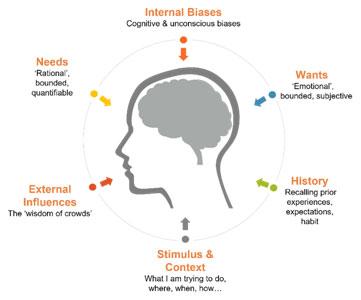In this article, I am going to explain why too much attention is spent by Customer Experience (CX) professionals on measuring the past, when they should be focused on shaping the future.
After over 25 years of Customer Experience as a named discipline, many businesses have a Voice of the Customer programme, have analysed and optimised customer journeys, and are reporting CX programme health using metrics like the Net Promoter Score (NPS), Customer Satisfaction (CSat) score, or the Customer Effort Score (CES), to name but a few.
But too many of these programs are retrospective, using these tools to analyse past customer journeys or experiences to try and identify challenges in the customer journey; to find errors, pinch points, or inefficiencies in the interactions that customers experience. Whilst this is necessary and laudable, the pandemic highlighted a significant problem with this approach; it is reliant on gathering enough historic data to analyse to identify these ‘moments of truth’ but, in a fast-moving environment, the patterns of consumer behaviour are constantly shifting.
We now live in a ‘VUCA’ world; volatile, uncertain, complex, and ambiguous. What we saw during the pandemic was customer behaviour changing at an unprecedented rate; old habits were abandoned, new behaviours started to emerge but were also abandoned as circumstances changed, and brands trying to figure out what behaviours were transitory, and which would become the ‘new normal’.
The two main problems for many of these ‘mature CX’ organisations were firstly that their historic data no longer reflected the behaviour of post-/pandemic customers, and secondly ‘decision latency’, where the time it took to figure out what was happening (and what to do about it) was longer than the behaviour existed. Neither of these were unique to CX, but an over-reliance on survey-based experience measurement certainly didn’t help. Neither did becoming more ‘inside out’, where the business tried to use their collective experience to try and predict what they thought the customer wanted.
What is needed now is a way to predict customer behaviour that is much more responsive to rapid changes in the wider world. For Anthrolytics, that is Predictive Behavioural Analytics, which is focused on what motivates customer behaviour and predicts what customers are likely to do when presented with a specific stimulus event.
‘Classic’ predictive analytics relies on gathering enough data over time to generate a model based on observed behaviours (effects) and relating these to specific variables (causes): simply put, an effect appears to be related to some causes. To do so, needs lots of data; both of cause and effect is needed, but in a VUCA world, the data is constantly shifting, so the primary challenge becomes how to gather enough cause and effect data quickly to build an effective model.
This complexity is further compounded when considering the number of factors that influence human decision making, as I illustrate in the following model:

With Predictive Behavioural Analytics, the emphasis is slightly different. It is focused on understanding the decision-making processes that lead to an observable behaviour: why do people do what they do, and what are they likely to do next? It does this by combining aspects of both data science and behavioural science, where behavioural science can explain some aspects of the qualitative nature of human experience and behaviour.
With this ability to model motivations, brands can answer questions like “if we do something we know a customer doesn’t like, what is the probability that they will cancel their account?”, or “if something changes in the wider world, what impact will that have a customer’s propensity to purchase?”. This converts the qualitative aspect of CX into a quantitative (and predictive) dataset.
For example, a utility company sends a customer a bill for much more than the usual amount (reflecting an increase in wholesale prices), it doesn’t need to survey customers to see whether they ‘liked’ the price hike or not; they already know. Now they also understand which customers are particularly focused on pricing (and why). Knowing both these things, and which customers were affected (sent the higher bill) the company can take proactive steps to reach out to the most affected customers and mitigate the effects before they start to look around for a competitor.
At this point, it is important to note that a big part of motivation is how customers already feel. Simply put, if the customer already likes your brand, they are more likely to ‘forgive’ a negative experience than if they dislike the brand.
The good news is that Predictive Behavioural Analytics can already do this, delivering actionable insights and models earlier than classical techniques and without constantly asking customers to fill in surveys or give star ratings.
About Peter Dorrington
Peteris Co-Founder and Chief Strategy Officer at Anthrolytics, is the inventor of Predictive Behavioural Analytics and an expert in Customer and Employee Experience Management Analytics. Peter has spent over 20 years advising boards on the strategic use of data and analytics related to customer and employee experience and is also an award-winning writer and speaker on the topic of CX/EX, the experience economy, Customer Relationship Management, and DevOps.

















